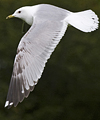 Mew Gull Larus canus canus; heinei; kamtschatschensis; brachyrhynchus
Mew Gull Larus canus canus; heinei; kamtschatschensis; brachyrhynchus
(last update: March 12, 2012)
Mew Gull (Larus canus) moulting into 3rd cycle (3CY): May - August
Mew Gull is a widespread species on the northern hemisphere with several sub-species: in N America brachyrhynchus,
in W Europe nominate canus, in W Asia and Russia heinei and in the Far
East sub-species kamtschatschensis.
The American race brachyrhynchus is a breeding bird of
Alaska, the American West coast and inland Canada. After the
breeding season, it disperses south along the coast to California. Brachyrhynchus can be readily told from nominate canus, and therefore
sometimes considered a full species: Mew Gull. The differences can
be found in the bill (in some birds obviously small), but most in
plumage.
Nominate canus is a common breeding bird in North Europe, wintering both in the breeding area and slightly south, to the northern coast of the Mediterranean.
The race heinei breeds from White Russia eastwards to central
Mongolia, in a broad band over the tundra region of inland U.S.S.R.
It can be found wintering in the central Asian states, southern
Black Sea and Caspian Sea and further south to the Persian Gulf.
Part of the eastern population of heinei may follow a more
eastern route to the coast of China.
Race kamtschatschensis breeds in eastern Siberia and, as the
name indicates, Kamtschatcha. In winter it moves southwards along
the coast, wintering in Japan, the Korea's and China. It is the
largest race, almost as large as Herring Gull. The description below largely follows from P.J. Grant: "Gulls, a guide to identification".
3CY Mew Gull
Mew Gull has a partial moult in spring. It starts in February and is completed by April, leaving birds in so-called "second summer" plumage. The head turns white, with only a few dark markings in some birds. The small primary tips wear off and the black areas turn paler, brownish.
From early summer to October, a complete
moult will bring birds in so-called "third
winter" or "adult winter" plumage.
The head is white with spots, most densely in the hind-neck. The
under-parts, tail-coverts and rump are white. The upper-parts are
medium grey, with broad white fringes on the tertials. The third
generation primaries and later the adult primaries have a clear-cut
black triangle on the outer-wing. Black sub-terminal markings run
down to P6 or P5. From P1-P9 the primaries show extensive white tips
and the two mirrors on P9 and P10 are obvious (there may even be a
small mirror on P8). The iris is brown, the bill is yellowish with a
faint black bill-band and the legs are yellowish, greenish or
greyish, often with a flesh-coloured hue.
In adult winter, brachyrhynchus develops only diffuse head streaking,
creating a diffuse grey head and no dark bill-band, whereas canus often has the head strongly mottled or streaked and often develops a
full bill-band in winter. Furthermore, the iris in brachyrhynchus is
paler, sometimes clear yellow.
"brachyrhynchus" Mew Gull 3CY May - August
 Mew Gull brachyrhynchus 2nd cycle (3CY), July 11 2012, Sitka National Historical Park, AK. Picture: Arman Moreno.
Mew Gull brachyrhynchus 2nd cycle (3CY), July 11 2012, Sitka National Historical Park, AK. Picture: Arman Moreno."canus" Mew Gull 3CY May - August
 Mew Gull canus-henei 3CY, May 28 2006, Bergen, Norway. Picture: Frode Falkenberg. Black spots in the 2nd generation secondary centres are a strong clue for eastern taxon heinei, and maybe as well for birds from the transition zone between canus and heinei.
Mew Gull canus-henei 3CY, May 28 2006, Bergen, Norway. Picture: Frode Falkenberg. Black spots in the 2nd generation secondary centres are a strong clue for eastern taxon heinei, and maybe as well for birds from the transition zone between canus and heinei. Mew Gull canus 3CY, July 16 2013, Zoetermeer, The Netherlands. Picture: Maarten van Kleinwee.
Mew Gull canus 3CY, July 16 2013, Zoetermeer, The Netherlands. Picture: Maarten van Kleinwee. Mew Gull canus 3CY, May 02 2017, Hoornderslag - Texel, the Netherlands.
Mew Gull canus 3CY, May 02 2017, Hoornderslag - Texel, the Netherlands. Mew Gull canus 3CY-type, May 02 2017, Hoornderslag - Texel, the Netherlands.
Mew Gull canus 3CY-type, May 02 2017, Hoornderslag - Texel, the Netherlands. Mew Gull canus 3CY, May 02 2017, Hoornderslag - Texel, the Netherlands.
Mew Gull canus 3CY, May 02 2017, Hoornderslag - Texel, the Netherlands.